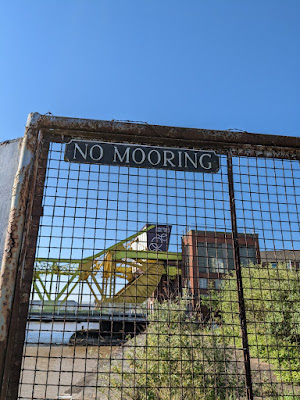Before the wetland bird survey count of the River Hull today, I took a slight detour and headed to the last stretch of the Beverley and Barmston Drain before it ends in the river. It was warm and sunny all day, with the occasional breeze, but very pleasant for an early morning walk.
The two surving Elms of Brunswick Avenue.
At Lockwood Street, I pause to enjoy the birds. A Swallow sits atop a lamppost. It's LED these days, but the Swallows have probably been sitting on older versions of lamp posts for many years, as it's a great singing spot by the bridge over the drain were they nest. The view SE at the top of the post.
Swallow
Song Thrush.
Reed Warbler.
From the river I could see the golden Greenwich Time Ball atop the Guildhall, now that all the scaffolding is gone. It looks great! I only noticed as I was scanning the sky following House Martins and Swallows, trying to find out where the House Martins might be nesting.
This Swallow was at the dry dock of High Street, singing. There are two or three pairs in my WebS stretch. One of them went to a nest under Drypool Bridge. I flush a Grey Wagtail from one of the docks.
Lesser Black-backed gull. There were not many gulls around today, which seems a feature of this year, possibly Avian Flu effects?
I got into a car park to take a photo of this sign. It's probably been a long time since mooring was an issue. Very little boat traffic in the river these days. Drypool Bridge in the background.
This other Swallow was singing nearby.
I was very surprised to see this spider in the open, the reason being that it had caught some prey. It's my first Steatoda nobilis, or Noble False Widow.
My heart skipped a beat when I saw two odd birds in the distance. They turned out to be domestic mallards, probably siblings with the same pattern.
A female Mallard was leading her four ducklings along the river. One of them was a bit reluctant to get to the water.
On the corner of Half Penny bridge there are a few pools in the mud as the tide drops. There were many mud shrimps, which were great to watch with their oversized antennae. These are favourite food for waders such as Dunlin and Redshank.
To fishish up, these Herring Gulls didn't mind walking on the glass of St Stephen.
This one even sat down.

















1 comment:
I've seen a report from the days when street lamps had fluorescent tubes and used to get warm, of a Red-Winged Blackbird in Canada which found that it could turn the light on in daylight by extending a wing over the photoelectric cell on top of the lamp.
Post a Comment